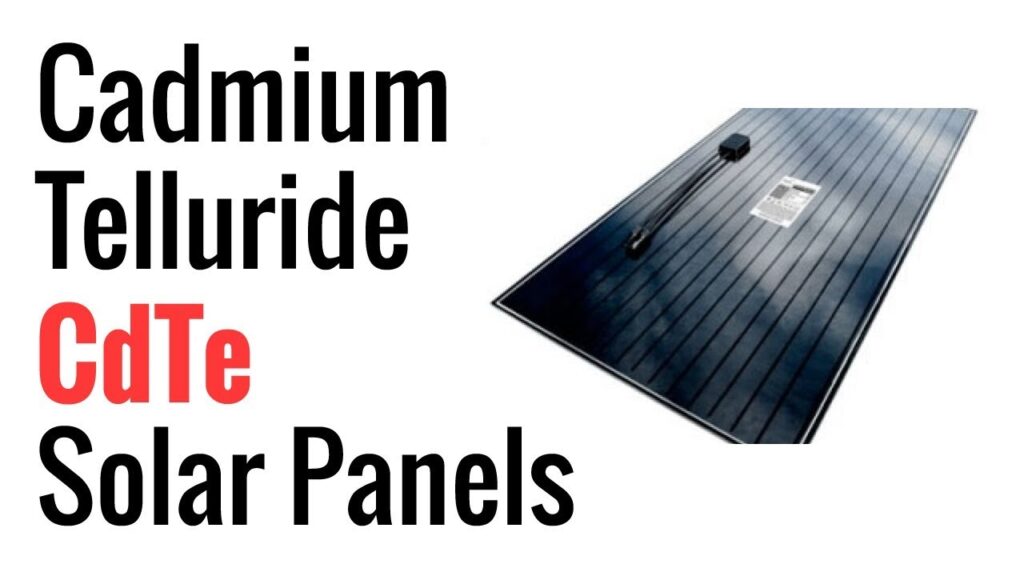In the pursuit of sustainable energy solutions, solar power has emerged as a frontrunner in the race to mitigate climate change and reduce our dependence on fossil fuels.
Among the diverse array of solar panel technologies available, cadmium telluride (CdTe) solar panels have gained prominence due to their unique properties and cost-effectiveness.
This article delves into the intricacies of CdTe solar panels, exploring their composition, working principles, advantages, limitations, and the potential they hold for shaping the renewable energy landscape.
Working Principle of Cadmium Telluride Solar Panel

The working principle of CdTe solar panels is based on the photovoltaic effect. When sunlight strikes the CdTe semiconductor layer, the energy from photons is absorbed, exciting electrons within the material.
This energy creates electron-hole pairs, generating a flow of electrons, i.e., electricity. This current can then be collected and used as a power source.
This energy excites electrons, promoting them from the valence band to the conduction band, creating electron-hole pairs.
The built-in electric field within the CdTe material separates these charge carriers, directing the electrons toward the back contact, and holes toward the front TCO layer.
The external circuit connected to the solar panel completes the circuit, allowing the flow of electrons from the back contact to the front TCO layer.
This movement of electrons constitutes an electric current, which can be harnessed as usable electricity.
The efficiency of CdTe solar panels in converting sunlight to electricity depends on factors such as the quality of the semiconductor material, the design of the panel, and external environmental conditions.
Composition and Structure:

Cadmium telluride solar panels are thin-film photovoltaic devices that convert sunlight directly into electricity through the photovoltaic effect.
Unlike traditional silicon solar panels, which use crystalline silicon wafers, CdTe panels employ a thin layer of cadmium telluride semiconductor material as the absorber layer.
This thin-film structure has several advantages, including reduced material consumption, flexibility, and ease of manufacturing.
The Basic Structure of a CdTe Solar Panel Consists Of Several Layers

1. Substrate:
Typically made from glass or flexible materials like plastic, the substrate provides structural support and protection to the solar cell layers.
2. Transparent Conductive Oxide (TCO) Layer:
This layer, often made from materials like indium tin oxide (ITO), allows sunlight to pass through while facilitating the extraction of generated electrons.
3. Cadmium Telluride Absorber Layer:
This is where the magic happens. Cadmium telluride, a compound of cadmium and tellurium, absorbs photons from sunlight and generates electron-hole pairs.
These charge carriers are then separated by an electric field within the material.
4. Back Contact:
Typically made of metal, this layer collects the electrons generated by the absorber layer and provides an electrical connection for the external circuit.
Advantages:
1. Cost-Effectiveness:
CdTe solar panels are known for their cost-effectiveness. The thin-film manufacturing process requires significantly less semiconductor material than traditional silicon panels, reducing production costs.
2. Efficiency in Low Light:
CdTe panels exhibit relatively higher efficiency in low light conditions compared to other solar technologies, making them suitable for regions with overcast skies or indirect sunlight.
3. Environmental Impact:
While cadmium is a toxic element, CdTe panels have a lower environmental impact when it comes to resource consumption and greenhouse gas emissions during production, when compared to silicon-based panels.
4. High Temperature Performance:
CdTe panels show less efficiency degradation at high temperatures compared to silicon panels, which can be advantageous in hot climates.
Limitations:

1. Cadmium Concerns:
Cadmium is a toxic heavy metal, and there are concerns regarding its potential environmental impact and human health risks in the case of mishandling or disposal of panels.
2. Efficiency Challenge:
CdTe solar panels historically had lower efficiency levels compared to silicon-based panels. However, advancements in research and technology have steadily improved CdTe panel efficiency.
3. Durability:
While CdTe panels can have a shorter lifespan compared to silicon panels, ongoing research aims to enhance their durability and longevity.
4. Toxicity Concerns:
Cadmium, a key component of CdTe panels, is a toxic heavy metal. Proper handling and disposal protocols are essential to prevent environmental contamination.
5. Efficiency Improvements:
While CdTe panels have achieved impressive efficiency levels, there is ongoing research to further enhance their performance and stability.
6. Market Competition:
The solar industry is highly competitive, with various technologies vying for dominance. CdTe panels need to maintain their advantages to stay relevant.
Future Prospects of Cadmium Telluride Solar Panels

Cadmium telluride solar panels have shown remarkable progress in recent years, with their efficiency levels steadily increasing and costs continuing to decline.
As research and development efforts persist, these panels hold the potential to further solidify their position as a reliable and affordable solar technology.
Innovations in recycling and responsible disposal methods are being explored to address concerns related to cadmium toxicity.
Additionally, the flexibility of thin-film CdTe panels opens the door for applications in niche areas where traditional panels might be less feasible, such as curved surfaces or portable solar devices.
In conclusion, cadmium telluride solar panels represent a promising avenue in the journey toward a more sustainable energy future.
Their cost-effectiveness, high-temperature performance, and efficiency in low-light conditions make them a compelling choice for a wide range of applications.
As the renewable energy landscape continues to evolve, CdTe panels could play a significant role in reshaping how we harness and utilize solar power.
